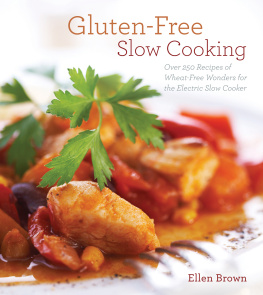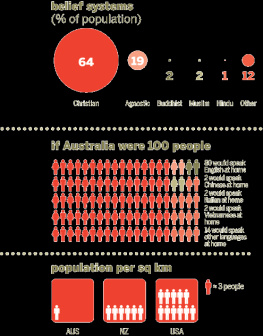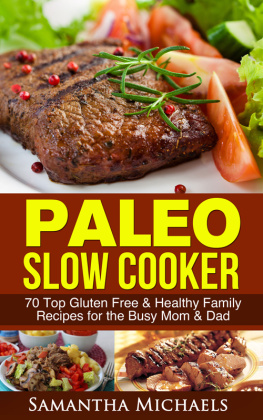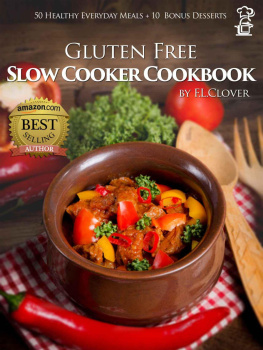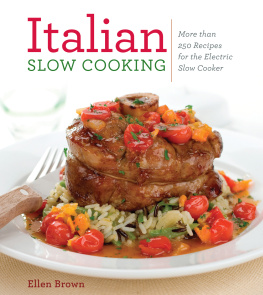Contents
This book is dedicated to my dear friend Suzanne Cavedon, who made me aware of the challenges of enjoying life on a gluten-free diet.
Preface
Theres much chatter in the food community today about slow food. The phrase was coined at the end of the twentieth century to signify the antithesis of fast food, and this international movement opposes the standardization of taste and culture. They are against processed foods and believe that everyone has a fundamental right to the pleasure of good food. And that certainly includes the millions around the world who must exclude gluten from their diet. A protein that acts like a poison in a body is hardly consistent with the principle of pleasurable eating.
Theres no better way to enjoy the pleasures of slow food than to cook it in a slow cooker. Slow cooking has been around for centuries, even before there were kitchens, or houses for that matter. The first slow cooking was done in pottery, as it is still today. By the fifth century BCE, iron pots holding simmering food were left to cook day and night in the fires embers.
Although slow cooking was a necessity in the past, today its a choice. With some advance preparation, busy people like you can enjoy a delicious, homemade meal cooked without anyone around to watch it. Thats a freedom not listed in the Bill of Rights, but a freedom it certainly is!
In this particular case, you are also assured that anything you cook from this book will be totally free of gluten. Theres freedom in that, too. For some dishes, such as cream soups or Moussaka, I adapted recipes to use gluten-free ingredients, and these are formulations that can be transferred from this book to all of your gluten-free cooking.
Foods compatible with slow cooking are part of all the worlds cuisines, and while some of these cuisines incorporate wheat, barley, and ryethe trinity of gluten-containing grainsinto dishes, most do not. Meals emerging from your slow cooker reflect a veritable United Nations because the recipes in this book are adapted from authentic dishes from far-flung corners of the earth. Youll find soups from China and stews from Brazil and Hungary. There are vegetarian dishes from India and chicken dishes from France and North Africa.
Ive also worked on ways to make cooking easier and more pleasurable as well as free from gluten. Youll find tricks for browning meat under the broiler rather than dirtying a skillet and how to effortlessly make dishes such as polenta and risotto that require laborious stirring when cooked on the stove instead of in the slow cooker.
Back in the early 1970s I received a slow cooker as a wedding present and promptly turned it into a planter because back then all the recipes written for the relatively new appliance called for cans of Cream of Something soup and other processed foods. This is my fourth slow cooker cookbook, and Im adamant that the slow cooker is a tool for the modern cook who uses only fresh ingredients. Thats all youll find here, and all those fresh ingredients are all gluten free.
Happy cooking!
Ellen Brown
Providence, Rhode Island
I ts not easy to follow a gluten-free diet. Wheat flour and contaminated ingredients are all around you. But in reality its far easier to follow the regimen when youre cooking for yourself at home rather than trusting that restaurants really know whats in their food.
Thats where the slow cooker becomes your pal. It does the cooking while youre living life. You go off to work and come home to find the aroma of a wonderful stew or soup. Or you take a walk in the woods and find a luscious dessert awaiting you. And with the range of dishes youll find in this book, a gluten-free diet is hardly synonymous with deprivation.
Understanding the need to live gluten-free starts with understanding how gluten can cause life-threatening problems if not removed from the diet of those who cannot tolerate it. But the good news is that following a gluten-free diet can mitigate debilitating symptoms and pain in as little as a few monthsusing food rather than a pharmacy.
Our bodies contain a complex and interlocking system to prevent harm. There is a network of organs, glands, and cell types all dedicated to warding off illness lumped under the heading of the immune system. But sometimes the immune system has been mysteriously programmed incorrectly and attacks healthy cells rather than potentially harmful ones. These maladies are termed autoimmune diseases.
Although autoimmune disorders are not fully understood, many medical authorities now accept some causes. The sources of these disorders include viruses, which change the information carried inside the cells, sunlight and other forms of radiation, certain chemicals, and drugs. There is also believed to be a connection to sex hormones, as many more women suffer from autoimmune disorders.
There are more than eighty types of autoimmune disease, including lupus, rheumatoid arthritis, and Graves disease. Some medical authorities also believe that multiple sclerosis is caused by an autoimmune response. While the aggravating factors in many of these diseases is complex, in the case of celiac disease it is really rather easy. Celiac disease is caused by an autoimmune response to gluten, one of the thirty proteins found in wheat, barley, and rye.
Humans as a species are unable to properly digest the gluten protein. Normal protein digestion involves a complete breakdown of protein into small particles called amino acids that are in turn absorbed by the small intestine and used by the body as a nutritional source. Those without gluten intolerance dont appear to be affected negatively by the inability to properly digest gluten in the way those with gluten intolerance are.

But for those who are intolerant, the undigested gluten protein gets absorbed into the lining of the small intestine but is not seen by the body as a source of nutrition. To the contrary, the bodys immune systems attacks these protein particles as something that needs to be destroyed, in very much the same way as it would attack an invading organism such as a virus, bacterium, or parasite. The attack by the immune system causes inflammation and damage to the small intestine, which prevents it from absorbing the nutrients from food that are important for staying healthy.
Normally, the small intestine is lined with tiny, hair-like projections called villi that resemble the deep pile of a plush carpet on a microscopic scale. It is these villi that work to absorb vitamins, minerals, and other nutrients from the food you eat. Without prominent villi, the inner surface of the small intestine becomes less like a plush carpet and more like a tile floor. The body is unable to absorb nutrients necessary for health and growth, resulting in malnutrition.
It is now clear that celiac disease is far more common than doctors once believed. New research reveals that celiac disease may be one of the most common genetic diseases. A federal government study estimates that 1 in every 133 Americans suffers from it. Thats more than 3 million people.
The condition is diagnosed by testing for three antibodiesanti-gliadin, anti-endomysial, and anti-tissue transglutaminaseall of which are present when an affected person is exposed to gluten but disappear when the offending grains are no longer consumed.
There are millions more people whose digestive problems dont fall under the strict definition of celiac disease because they do not test positively for the antibodies but who have found that following a gluten-free diet helps them. Rather than terming them gluten-intolerant, theyre termed gluten-sensitive. This group could include up to 30 percent of the American population.

